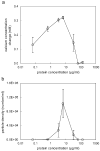The nucleation and growth of calcium phosphate by amelogenin
- PMID: 19079557
- PMCID: PMC2597808
- DOI: 10.1016/j.jcrysgro.2007.02.035
The nucleation and growth of calcium phosphate by amelogenin
Abstract
The nucleation processes involved in calcium phosphate formation in tooth enamel are not well understood but are believed to involve proteins in the extracellular matrix. The ability of one enamel protein, amelogenin, to promote the nucleation and growth of calcium phosphate was studied in an in vitro system involving metastable supersaturated solutions. It was found that recombinant amelogenin (rM179 and rp(H)M180) promoted the nucleation of calcium phosphate compared to solutions without protein. The amount of calcium phosphate increased with increasing supersaturation of the solutions and increasing protein concentrations up to 6.5 μg/mL. At higher protein concentrations, the amount of calcium phosphate decreased. The kinetics of nucleation was studied in situ and in real time using a quartz crystal microbalance (QCM) and showed that the protein reduced the induction time for nucleation compared to solutions without protein. This work shows a nucleation role for amelogenin in vitro which may be promoted by the association of amelogenin into nanosphere templates, exposing charged functionality at the surface.
Figures





Similar articles
-
Amelogenin as a Promoter of Nucleation and Crystal Growth of Apatite.J Cryst Growth. 2011 Feb 1;316(1):106-117. doi: 10.1016/j.jcrysgro.2010.12.005. Epub 2010 Dec 9. J Cryst Growth. 2011. PMID: 30828107 Free PMC article.
-
Control of Calcium Phosphate Nucleation and Transformation through Interactions of Enamelin and Amelogenin Exhibits the "Goldilocks Effect".Cryst Growth Des. 2018 Dec 5;18(12):7391-7400. doi: 10.1021/acs.cgd.8b01066. Epub 2018 Oct 22. Cryst Growth Des. 2018. PMID: 32280310 Free PMC article.
-
Biomimetic Precipitation of Uniaxially Grown Calcium Phosphate Crystals from Full-Length Human Amelogenin Sols.J Bionic Eng. 2011 Jun 10;8(2):114-121. doi: 10.1016/S1672-6529(11)60017-6. J Bionic Eng. 2011. PMID: 22140380 Free PMC article.
-
Amelogenins: assembly, processing and control of crystal morphology.Matrix Biol. 2001 Sep;20(5-6):293-305. doi: 10.1016/s0945-053x(01)00154-8. Matrix Biol. 2001. PMID: 11566263 Review.
-
Molecular mechanisms of dental enamel formation.Crit Rev Oral Biol Med. 1995;6(2):84-108. doi: 10.1177/10454411950060020701. Crit Rev Oral Biol Med. 1995. PMID: 7548623 Review.
Cited by
-
Mineralization of calcium phosphate controlled by biomimetic self-assembled peptide monolayers via surface electrostatic potentials.Bioact Mater. 2020 Mar 29;5(2):387-397. doi: 10.1016/j.bioactmat.2020.03.003. eCollection 2020 Jun. Bioact Mater. 2020. PMID: 32258828 Free PMC article.
-
Sequence-Defined Energetic Shifts Control the Disassembly Kinetics and Microstructure of Amelogenin Adsorbed onto Hydroxyapatite (100).Langmuir. 2015 Sep 29;31(38):10451-60. doi: 10.1021/acs.langmuir.5b02549. Epub 2015 Sep 18. Langmuir. 2015. PMID: 26381243 Free PMC article.
-
Hydrolysis of amelogenin by matrix metalloprotease-20 accelerates mineralization in vitro.Arch Oral Biol. 2011 Dec;56(12):1548-59. doi: 10.1016/j.archoralbio.2011.06.016. Epub 2011 Jul 20. Arch Oral Biol. 2011. PMID: 21774914 Free PMC article.
-
Improved protocol to purify untagged amelogenin - Application to murine amelogenin containing the equivalent P70→T point mutation observed in human amelogenesis imperfecta.Protein Expr Purif. 2015 Jan;105:14-22. doi: 10.1016/j.pep.2014.09.020. Epub 2014 Oct 13. Protein Expr Purif. 2015. PMID: 25306873 Free PMC article.
-
Mimicking the Self-Organized Microstructure of Tooth Enamel.J Phys Chem C Nanomater Interfaces. 2008 Mar 22;112(15):5892-5899. doi: 10.1021/jp077105+. J Phys Chem C Nanomater Interfaces. 2008. PMID: 19169386 Free PMC article.
References
-
- Lowenstam HA, Weiner S. On Biomineralization. Oxford University Press; New York: 1989.
-
- Fincham AG, Moradian-Oldak J, Simmer JP. J Struct Biol. 1999;136:270. - PubMed
-
- Moradian-Oldak J. J Matrix Biol. 2001;20:293. - PubMed
-
- Diekwisch TGH, Berman BJ, Gentner S, Slavkin HC. Cell Tissue Res. 1995;279:149. - PubMed
-
- Moradian-Oldak J, Tan J, Fincham AG. Biopolymers. 1998;46:225. - PubMed
Grants and funding
LinkOut - more resources
Full Text Sources
Other Literature Sources
